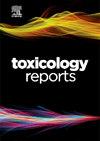吸食合成大麻素ADB-BUTINACA引起的非自愿中毒:一例报告
Q1 Environmental Science
引用次数: 0
摘要
合成大麻素在全球越来越受欢迎,检测并不普遍。我们报告一位27岁的男子因突然头痛、恶心、眩晕、眼睛发红和心悸而被送往急诊室。他证实,当天早些时候,就在他出现症状之前,他一直在吸电子烟。尽管娱乐性药物的即时检测结果均为阴性,但液相色谱-四极杆飞行时间质谱(LC-QTOF-MS)分析显示,电子烟的液体中含有合成大麻素ADB-BUTINACA。LC-QTOF-MS代表了药物检测领域的重大进步,提供更高的灵敏度,特异性和更广泛的可检测物质。临床医生应该意识到,除了电子烟中尼古丁和有毒金属的有害影响外,电子烟还可能含有合成大麻素或其他娱乐性药物,包括新的精神活性物质(NPS),这可能导致非自愿中毒,并可能产生严重的不良反应。当临床表现和/或初始娱乐性药物测试结果不确定时,LC-QTOF-MS的附加测试可能是有价值的。本文章由计算机程序翻译,如有差异,请以英文原文为准。
Involuntary intoxication caused by vaping the synthetic cannabinoid ADB-BUTINACA: A case report
Synthetic cannabinoids are gaining popularity globally and detection is not commonly available. We report a 27-year-old man who was admitted to the emergency room because of sudden headache, nausea, vertigo, red eyes and palpitations. He confirmed that he had been vaping an electronic cigarette (e-cigarette) earlier that day just before the onset of his symptoms. Despite all negative results in the point-of-care test for recreational drugs, the liquid chromatography-quadrupole time-of-flight mass spectrometry (LC-QTOF-MS) analysis showed that the liquid of the e-cigarette contained ADB-BUTINACA, a synthetic cannabinoid. LC-QTOF-MS represents a significant advancement in the field of drug detection, offering higher sensitivity, specificity, and a broader spectrum of detectable substances. Clinicians should be aware that besides the harmful effects of nicotine and toxic metals in e-cigarettes, e-cigarettes may also contain synthetic cannabinoids or other recreational drugs including new psychoactive substances (NPS), which can cause involuntary intoxication with potentially severe adverse effects. When clinical presentation and/or initial recreational drugs testing results are inconclusive, additional testing with LC-QTOF-MS can be valuable.
求助全文
通过发布文献求助,成功后即可免费获取论文全文。
去求助
来源期刊

Toxicology Reports
Environmental Science-Health, Toxicology and Mutagenesis
CiteScore
7.60
自引率
0.00%
发文量
228
审稿时长
11 weeks
 求助内容:
求助内容: 应助结果提醒方式:
应助结果提醒方式:


